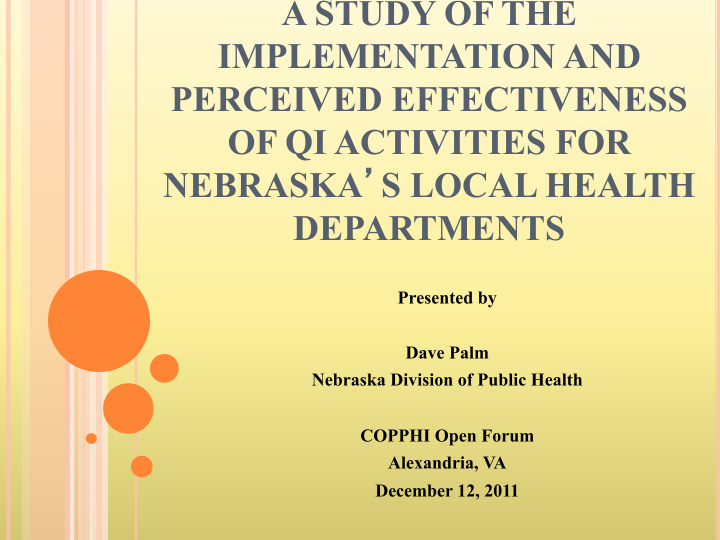



A STUDY OF THE IMPLEMENTATION AND PERCEIVED EFFECTIVENESS OF QI ACTIVITIES FOR NEBRASKA ’ S LOCAL HEALTH DEPARTMENTS Presented by Dave Palm Nebraska Division of Public Health COPPHI Open Forum Alexandria, VA December 12, 2011
O UTLINE OF P RESENTATION ¢ Background of Public Health in Nebraska ¢ Purpose of the Study ¢ Study Methods – Survey and Facilitated Discussion ¢ Major Findings ¢ Conclusions and Next Steps
B ACKGROUND OF LHD S ¢ In 2001, 16 new regional LHDs formed, ranging from 2 to 10 counties ¢ LHDs now cover entire state ¢ Regional LHDs have many advantages (economies of scale), but distance and capacity levels can be challenges
P URPOSE OF THE S TUDY ¢ To assess the current status of Nebraska ’ s LHDs in implementing public health quality improvement (QI) initiatives. ¢ From the practice perspective, QI is one of the standards of accreditation.
S TUDY M ETHODS ¢ In 2011, the COPH conducted a survey of LHD directors using: The QI Taxonomy developed by Bill Riley at the University of Minnesota The 2011 Annual Survey of the Multi-State Learning Collaborative – University of Southern Maine. NACCHO ’ s 2010 National Profile of LHD Survey ¢ Survey reviewed by the Nebraska PBRN
LHD Q UALITY I MPROVEMENT S URVEY v Survey Content v Are any QI-related programs, initiatives, or activities currently implemented in the LHD? v If so, what specific QI tools and processes are used? v What quality measures (if any) are used, what data are collected for the measures, and how is that data collected? v What is the perceived appropriateness of the adopted quality measures and how relevant are they to the practice setting? v What is the perceived effectiveness of the implemented QI activities? v What are the challenges of implementing the QI activities?
S TUDY P OPULATION v Sample v Surveyed all 21 LHD directors v Response v Total of 19 responses (90.5% of total sample) v Regional: n = 17 v Single-County: n = 2
Q UALITY I MPROVEMENT : A GENCY C ULTURE
Q UALITY I MPROVEMENT S TRATEGIES
Q UALITY I MPROVEMENT A CTIVITIES v In the past 12 months, a median of 3.0 (N = 8) formal projects has been implemented in LHDs.
P RIMARY P ROGRAM OR A DMINISTRATIVE A REA T ARGETED FOR QI
Q UALITY I MPROVEMENT T ECHNIQUES v 47.1% (n = 8) of LHDs indicated that QI techniques were used for any QI program or intervention.
Q UALITY I MPROVEMENT P LANS
C HALLENGES ¢ Infrastructure “ Getting started ” [Need for] “ an experienced, dedicated staff person to help with education and the process ” (Respondent) ¢ Resources Time Money Staff and Staff Knowledge ¢ Training [Need for] training in applicable QI measuring systems ” and “ techniques ” (Respondent) ¢ Data Limitations Collection [Need for] “ access to appropriate data for the best measures ” (Respondent)
O PPORTUNITIES AND B ARRIERS
F UTURE R ESEARCH ¢ A recent RWJF funded project will build on the information from the QI survey. ¢ The purpose is to examine the relationship between QI readiness and accreditation readiness based on the size of the regional health departments ¢ In-depth site visits will also be conducted in four regional LHDs ¢ Final results will be published by March, 2013
Dave Palm Office of Community Health and Performance Management Nebraska Division of Public Health Telephone: (402) 471-0146 E-mail: David.Palm@Nebraska.Gov
Recommend
More recommend